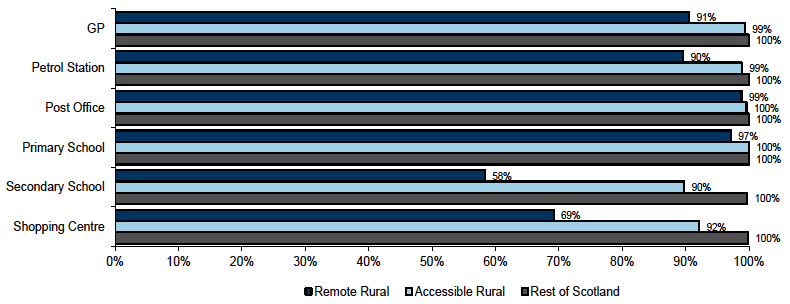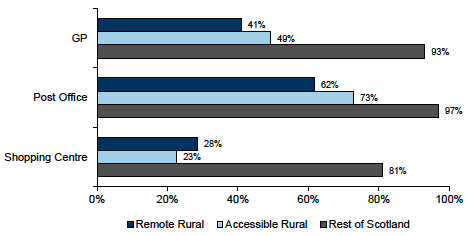Understanding the Scottish rural economy: research paper
This report outlines the Scottish Government's understanding of the Scottish rural economy and presents economic and social data.
Access and Convenience of Services
As noted in the previous section, access is a main driver of rural disadvantage, both for individuals and businesses. We do not have current data around access for business to services, so as a proxy it can be useful to see the challenges reported by households in relation to service access, particularly as in Remote Rural areas a much higher proportion of people work from home, as shown in the section above on employment and work pattern.
Chart 17: Percentage within 15 minute drive time of service by geographic area, 2016

Source: Scottish Index of Multiple Deprivation, 2016 (Using Scottish Government Urban Rural Classification 2013-2014)
Chart 17 shows that only rural areas of Scotland are not within a 15 minute drive time to key services. For example 91% of people in Remote Rural areas and 99% of people in Accessible Rural areas live within a 15 minute drive time to a GP compared to 100% of the population in the rest of Scotland. It should be noted that that Scottish Index of Multiple Deprivation ( SIMD) 2016 is calculated based upon the 2011 Data Zone boundaries.
The greatest difference observed in drive time is to the nearest secondary school. In Remote Rural areas, 58% people live within a 15 minute drive time to a secondary school, compared to 92% of people in Accessible Rural areas and 100% of people in the rest of Scotland.
Chart 18: Percentage within 15 minute drive time by public transport of service, by geographic area, 2016

Source: Scottish Index of Multiple Deprivation, 2016 (Using Scottish Government Urban Rural Classification 2013-2014)
Chart 18 shows that the proportion of people within a 15 minute drive time to key services by public transport is much lower in both remote and Accessible Rural areas compared to the rest of Scotland. The figures are particularly low in rural areas with respect to drive time to the nearest shopping centre.
Table 9: Households with home internet access by geographic area, 2015
| Remote Rural | Accessible Rural | Rest of Scotland | |
|---|---|---|---|
| Yes | 79% | 85% | 80% |
| No | 21% | 15% | 20% |
| Don't know | - | - | 0% |
| All | 100% | 100% | 100% |
Source: Scottish Household Survey, 2015 (Using Scottish Government Urban Rural Classification 2013-2014)
From table 9 it can be seen that the households with the highest proportion of home internet access are in Accessible Rural areas (85%) followed by the rest of Scotland (80%). The lowest proportion of households with home internet access are in Remote Rural areas (79%).
Table 10: Households with broadband (households with internet connection only) by geographic area, 2013 [12]
| Remote Rural | Accessible Rural | Rest of Scotland | |
|---|---|---|---|
| DSL broadband (via your phone line) | 90% | 80% | 59% |
| Broadband via cable, optical fibre, Ethernet, PLC etc. ( e.g. Virgin) | 3% | 16% | 31% |
| Broadband via satellite, public WiFi | 5% | 3% | 7% |
| Mobile broadband via mobile phone network (at least 3G) via a mobile phone or smartphone | 3% | 11% | 9% |
| Mobile broadband via mobile phone network (at least 3G) via a dongle or card | 1% | 0% | 1% |
| Dial-up access over a normal telephone line or ISDN | - | 0% | 0% |
| Other | 2% | 2% | 2% |
Source: Scottish Household Survey, 2015 (Using Scottish Government Urban Rural Classification 2013-2014)
Of those households with home internet access, almost all of them have a broadband connection. This is true for all areas of Scotland (see table 10). These figures show how households access internet services and do not reflect the availability of internet services across the whole of Scotland. In addition, the availability of superfast broadband is much lower in rural areas than in the rest of Scotland. [13]
Contact
There is a problem
Thanks for your feedback